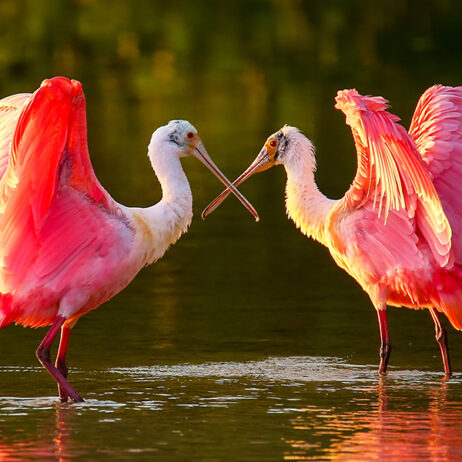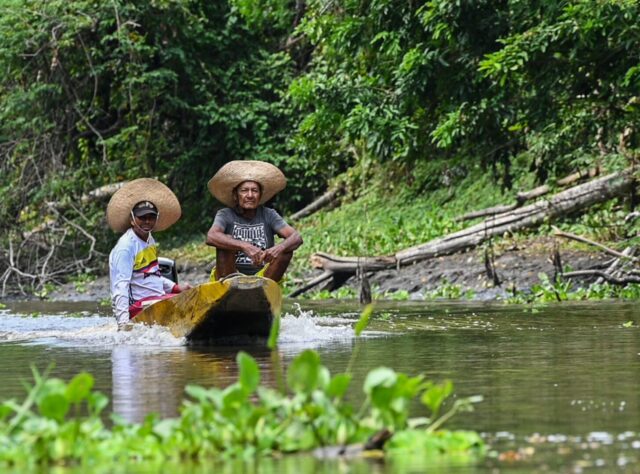
Two fishermen from the Bocas de Barbacoas community head out onto the water. Credit: Fundación Biodiversa Colombia (FBC)
In Colombia’s Middle Magdalena Valley, life follows the rhythm of the water. Each year, during the subienda – the annual fishing season – families from nearby towns and even Barrancabermeja and Puerto Berrío, two cities more than an hour away, set out in their boats towards the wetlands. With nets, lines, hooks, knives, and baskets on board, they motor along the Magdalena River, gradually leaving behind the busy towns as they enter the vast solitude and lush green of the Barbacoas marshes.
Many fishing families will stay here for the next two weeks, their days falling into a gentle rhythm of early mornings, long hours on the water, and warm evenings spent talking, drinking, and playing cards.
“October and November are when the fish are most abundant. Those are times you wish would never end.
For four or five days, you can settle your debts, earn income, or purchase what you need. Those are beautiful moments.” Enrique Mahecha, a local fisherman who has lived in Bocas de Barbacoas since 2000.
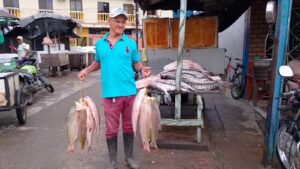
A local fisherman shows his catch at the market in Bocas de Barbacoas. Credit: FBC
An unbroken tradition
Fishing here relies on traditional methods passed down through generations. With hook and line, they catch Trans-Andean Shovelnose Catfish (Sorubim cuspicaudus), locally called Blanquillo. With cast nets or atarrayas, they haul in Bocachico (Prochilodus magdalenae) and Pataló (Ichthyoelephas longirostris). Many of these are prehistoric-looking catfish, with long “whiskers” or barbels – sensory organs that help them “taste” the water, navigate, and locate potential prey.
Standing in their separate boats, each fisher casts their own net out at the same moment, the meshes flicking open like silver fans across the water. Working in synchrony like this, they can make the most of large shoals of fish.
A place of calm
Fishing here is much more than just work. It’s a way of life, of simplicity and contentment.
“I enjoy watching the forest, the animals, and listening to the birds”. María Paniagua, a local fisherwoman
María explains how life here is easier than in other parts of Colombia. “There are fewer expenses compared to the city. Food is available from the water and from backyard gardens. It’s peaceful, and since electricity arrived, living conditions have improved a lot.”
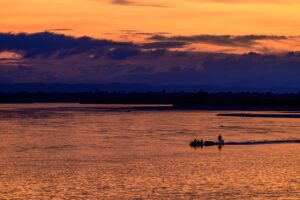
Sunset over the wetlands. The fishers start to bring their boats in for the evening, silhouetted against the rich orange and purple colours of the sky. Credit: FBC
For Manuel ‘Chindo’ Tovar, who has fished here for 15 years, it is also the tranquillity that drew him to this place. And for Enrique, the landscape is more than just a home – it’s part of his family’s story.
“I value this place very much,” he says. “I raised my children here and gave them an education. The story of being able to raise your children in this region – that’s something to be proud of. The little I have, I owe to Bocas de Barbacoas.”
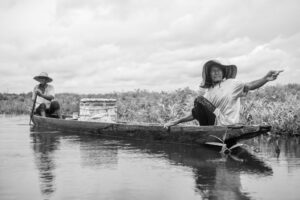
For the fishing communities of Bocas de Barbacoas, these wetlands are not just a resource. They are the bedrock of a way of life that has thrived for generations. That way of life is now under threat. Credit: FBC
A livelihood at risk
Today, these marshes – a lifeline for wildlife and the local communities – are under immediate threat from an encroaching manmade canal. You can read more about this here.
But with your help, World Land Trust’s autumn appeal will enable FBC to expand the El Silencio Reserve, restore the canal’s banks, and protect the region’s communities and wildlife.
These local voices remind us what’s at stake: not just a haven for threatened wildlife, but a community and culture that has thrived here for generations.
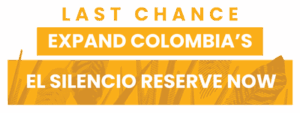
Support our autumn appeal and the local fishing communities of Bocas de Barbacoas before it’s too late.


